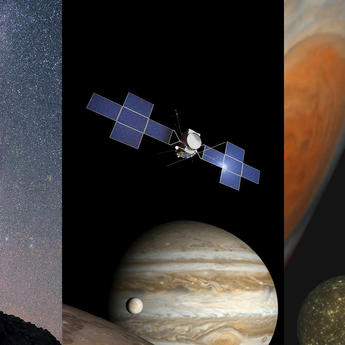The first European mission to Jupiter
Airbus developed and built the JUICE (JUpiter ICy moons Explorer) spacecraft for the European Space Agency, bringing together 80 partners from 23 countries and harnessing the brainpower of more than 2,000 people.
Once it reaches its destination in 2031, JUICE will spend four years studying Jupiter and its icy moons. The mission will focus on three of Jupiter’s Galilean moons: Europa, Ganymede and Callisto, which are covered by icy crusts.
JUICE builds on the scientific and technological heritage of previous European planetary science missions to Mars, Venus and Mercury and will pave the way for future deep space exploration of the outer Solar System.
On the way to Jupiter
On 14th April 2023, JUICE lifted off from the European spaceport in Kourou, French Guiana, aboard an Ariane 5 rocket and began its eight-year cruise to Jupiter.
The 6.2 tonne spacecraft is due to arrive at Jupiter in 2031 after a series of gravitational slingshots from Venus and Earth to propel it along the way. Its main mission will be to explore the giant planet’s three largest icy moons and investigate whether there are liquid oceans under the crust of these icy moons, which might harbour organic components or even life.
The first two and a half years of JUICE’s four-year mission will be spent on making about 30 observation overflights of the three moons. It will study the structure, dynamics and the subsurface oceans of the icy moons. The last year will be spent in orbit around Ganymede to observe this moon in much greater detail.
Learn all about tihs exciting new journey

The challenges of space exploration
The challenges are enormous. JUICE has to cope with very low and very high temperatures as it orbits Earth, Mars and Venus for gravity assist manoeuvres to build up enough speed to reach Jupiter’s orbit. Jupiter’s cold environment also makes it hard to collect energy.
The spacecraft carries 10 state-of-the-art scientific instruments, including cameras, spectrometers, an ice-penetrating radar, an altimeter, a radio science experiment, a particle package and various magnetic and electric field sensors.
Because its scientific instruments require a very high level of magnetic cleanliness, the spacecraft itself may not generate electromagnetic signals. Since all electronic systems generate electromagnetic waves when operating, Airbus engineers have devised a way to reduce them as much as possible.
The latest JUICE news
In the spotlight
-
 Stories Space
Stories SpaceJUICE: throwback to an out of this world rescue!
As we commemorate a year since the launch of the Jupiter Icy Moons Explorer (JUICE), we revisit a pivotal moment in space exploration history when the mission encountered a formidable challenge just… -
 Stories Space
Stories SpaceJUICE, searching for life on Jupiter’s icy moons
-
 Press releases Space
Press releases SpaceTo Jupiter and beyond: Airbus-built JUICE begins its epic odyssey
-
 Stories Space
Stories SpaceGuiding JUICE to Jupiter – learn about the technical mountains we had to climb
-
 Stories Space
Stories SpaceFirst the Moon, now Jupiter!








